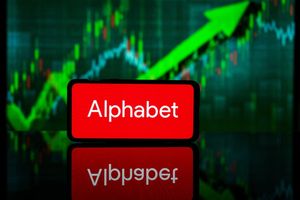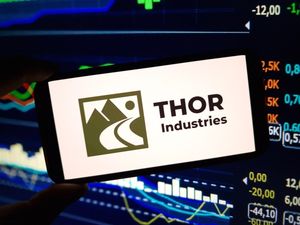
A significant transformation is underway in the investment landscape, as portfolios increasingly pivot towards gold and silver stocks, a phenomenon dubbed a "tectonic shift" by Canaccord Genuity Senior Investment Advisor Cam Currie. Speaking on The Northern Miner (TNM) Podcast around September 23, 2025, Currie underscored a profound re-evaluation of asset allocation, driven by a confluence of macroeconomic pressures and geopolitical instability. This strategic reallocation signals a growing sentiment among investors to seek refuge and growth in hard assets amidst an uncertain global financial environment.
This shift isn't merely a fleeting trend but a fundamental reorientation, with Currie emphasizing that gold stocks, in particular, are poised for sustained robust performance, offering superior opportunities compared to the physical metals themselves. The immediate implications for the market are clear: a renewed focus on the precious metals sector, a call for strategic diversification, and an anticipation of a crucial "narrative shift" that could unlock unprecedented growth in gold and silver equities.
Unpacking the Drivers: Geopolitics, Central Banks, and Eroding Confidence
The genesis of this "tectonic shift" is rooted in a complex interplay of global events and economic realities. Currie's insights, shared on the TNM Podcast in an episode titled "'Tectonic shift' as portfolios increase gold, ft Canaccord's Currie," pinpoint several key catalysts. A major driver has been the aggressive accumulation of gold by central banks, coupled with strong investment demand, a trend that significantly accelerated following the onset of the Russia-Ukraine conflict in 2022. This institutional buying spree has contributed to gold's substantial rise, reportedly over 41% in 2025 alone.
Geopolitical tensions extend beyond the immediate conflict, with Currie highlighting the strategic gold accumulation by BRICS nations. These emerging economies are reportedly moving towards a new gold standard and de-dollarization, a development he suggests is often underestimated by Western markets, yet holds profound implications for global finance. Furthermore, the anticipation of impending interest rate cuts by major central banks is widely viewed as a supportive factor for higher gold prices, making precious metals more attractive as non-yielding assets.
Underlying these drivers is a broader erosion of confidence in traditional fiat currencies and bond markets. With sovereign debt reaching unprecedented levels globally, investors are increasingly questioning the long-term stability of conventional financial instruments. This skepticism propels gold and silver into the spotlight as reliable stores of value and crucial diversification tools, especially in an environment where equity markets are perceived as elevated and potentially susceptible to a "bubble." Currie consistently points out that gold and silver stocks remain significantly undervalued and under-owned, representing a substantial opportunity for growth that larger institutional investors may be overlooking.
Winners and Losers: The Shifting Sands of Corporate Fortunes
This profound reorientation of investment capital towards precious metals is set to create distinct winners and losers across the financial landscape. At the forefront of the beneficiaries are major publicly traded gold and silver mining companies. These entities offer leveraged exposure to metal price movements, often outperforming the underlying commodities during bull markets. Companies like Newmont Corporation (NYSE: NEM), the world's largest gold producer, and Barrick Gold (NYSE: GOLD), a Canadian powerhouse, are poised for significant stock appreciation. Similarly, prominent silver miners such as Pan American Silver Corp. (NASDAQ: PAAS) and First Majestic Silver Corp. (NYSE: AG) are likely to see increased investor interest and enhanced profitability.
The surge in gold and silver prices—with gold reportedly breaking through US$2,450 per ounce in 2024 and exceeding $3,500/oz in Q2 2025—translates directly into expanded profit margins for these mining companies. As revenues climb faster than their relatively stable cost structures, these companies will likely see a boost in exploration budgets, enabling them to discover and develop new deposits. Increased profitability will also incentivize them to ramp up production from existing operations and potentially reopen previously idled mines. This bullish environment could also foster consolidation within the sector, as companies seek to optimize operations and capitalize on strategic positioning.
Conversely, certain sectors and companies may find themselves on the losing side of this "tectonic shift." Companies heavily reliant on a strong U.S. dollar, such as U.S. dollar-denominated exporters or those with significant dollar-denominated debt, could face headwinds if de-dollarization efforts and a weakening dollar diminish their profitability or increase borrowing costs. Financial institutions with substantial investments in U.S. Treasury bonds could also be vulnerable if bond market instability leads to a decline in the value of these holdings. Moreover, industries that use gold as a primary raw material, such as high-end jewelry, electronics, and dentistry, may experience increased operational costs, potentially squeezing profit margins and leading to higher consumer prices.
The broader implications extend to companies heavily reliant on stable bond markets. Interest-rate sensitive sectors like real estate, utilities, and certain financial services could struggle if bond market instability leads to volatile or rising long-term interest rates. Highly leveraged companies might face increased borrowing costs, while pension funds and insurance companies, which depend on stable, long-term bond returns, could see their financial health impacted by significant downturns in bond markets. This scenario underscores a broader reallocation of capital away from traditional assets towards the perceived safety and growth potential of precious metals.
Wider Significance: A New Era for Global Finance
The "tectonic shift" towards gold and silver allocation transcends mere investment strategy; it signals a profound recalibration within the global financial system, deeply intertwined with broader industry trends. This movement is a direct response to accelerating de-dollarization efforts, persistent inflationary pressures, and a landscape of escalating geopolitical realignments. Nations, particularly those within the BRICS alliance, are actively diversifying their foreign exchange reserves away from the U.S. dollar, with gold serving as a primary alternative. This strategic accumulation by central banks, driven by a desire for independence from U.S. monetary policy and a hedge against currency fluctuations, is a powerful, long-term driver for gold demand that is often underestimated by Western markets.
Furthermore, the specter of persistent inflation continues to loom large, eroding the purchasing power of fiat currencies and compelling investors to seek tangible assets that can preserve wealth. Gold and silver have historically proven to be effective hedges against inflation, with their prices soaring during periods of economic uncertainty and currency debasement. The current geopolitical climate, marked by ongoing conflicts in Eastern Europe and the Middle East, coupled with trade disputes and shifts in global power dynamics, further amplifies the demand for safe-haven assets. These instabilities diminish confidence in traditional financial instruments, channeling capital towards the perceived security of precious metals.
The ripple effects of this shift extend throughout the mining industry and its associated sectors. While gold and silver mining companies are direct beneficiaries, other mining sectors, particularly those focused on industrial metals, might experience varied impacts as capital is reallocated. The entire supply chain for precious metals, from exploration and refining to transportation and vaulting services, is poised for increased activity and potential growth. This shift could also spur innovation in mining technologies, driving the development of more efficient and sustainable extraction methods, as well as advancements in recycling technologies for precious metals.
From a regulatory and policy perspective, this trend underscores the continuous push for greater transparency in precious metals markets to prevent price manipulation, with discussions around mechanisms like Goldfix and enhanced traceability. Financial institutions involved in precious metals trading will continue to operate under stringent national and international regulations, including anti-money laundering (AML) and Know Your Customer (KYC) measures. Moreover, the accelerating de-dollarization, manifested through increased central bank gold reserves, could lead to the emergence of new gold-backed financial instruments for international trade and the establishment of regional gold exchanges, potentially further fragmenting the international monetary system and ushering in new zones of monetary influence. Historically, periods of significant economic and geopolitical upheaval, such as the 1970s stagflation, the dot-com bubble burst, and the 2008 financial crisis, have consistently seen gold and silver emerge as preferred safe havens, reinforcing their enduring role in investor portfolios.
What Comes Next: Navigating a Golden Future
The "tectonic shift" in investment portfolios towards gold and silver stocks signals not just a temporary trend, but a potentially enduring reorientation with significant short-term and long-term implications. In the immediate 6-12 months, the outlook for precious metals remains largely bullish. Gold prices, which have already seen a remarkable surge, are projected by some analysts to breach $4,000 per ounce, with even bolder forecasts suggesting $5,000 per ounce by early next year if current fundamental drivers persist. Silver, often more volatile, is also anticipated to continue its upward trajectory, potentially nearing the $50 level. This momentum will be sustained by ongoing geopolitical instabilities, persistent inflationary pressures, and the relentless, strategic gold acquisition by central banks, particularly those in emerging markets like China and India, as part of their de-dollarization efforts.
Looking further out, over the next 2-5 years, the structural underpinnings for precious metals demand appear robust. Analysts project gold to average well over $3,000/oz in 2026, with long-term targets reaching over $5,000 by 2030. Silver, with its dual role as both a precious and an industrial metal, is particularly well-positioned for long-term growth. Its increasing applications in critical technologies such as solar panels, electric vehicles, 5G, and AI, driven by the global push for carbon emission reduction, are expected to create a substantial and deepening market deficit. The historically high gold-to-silver ratio also suggests that silver may be significantly undervalued relative to gold, offering considerable upside potential as the ratio potentially reverts to its historical mean.
For investors, strategic adaptation is paramount. This shift necessitates a careful review and rebalancing of portfolios to include a strategic allocation to precious metals, with financial experts often recommending 5-10% for optimal diversification. Understanding the distinct roles of gold (as a primary safe haven for wealth preservation) and silver (offering higher growth potential due to its industrial demand and volatility) is crucial. Investment vehicles can range from physical bullion for tangible security to ETFs for liquidity, or direct investment in mining and royalty companies for leveraged exposure. A long-term "buy-and-hold" mindset, coupled with dollar-cost averaging, will be vital to navigate potential volatility.
For companies in the precious metals sector, opportunities abound. Gold and silver mining companies will likely see increased access to capital, incentivizing greater exploration and production activities. However, industrial users of silver will need to innovate to manage rising input costs and secure resilient supply chains. Potential challenges include continued price volatility, the lack of income generation from physical metals, and storage costs. Should global economic recovery strengthen significantly with moderating inflation and stable geopolitics, the explosive growth in precious metals might temper. Conversely, a prolonged stagflationary environment would be the most bullish scenario, further cementing gold and silver's role as essential portfolio components.
Comprehensive Wrap-up: A Golden Future in Uncertain Times
The insights from Canaccord Genuity's Cam Currie underscore a pivotal moment in financial markets: a "tectonic shift" in investment portfolios towards gold and silver stocks. This reorientation is not a fleeting trend but a deeply rooted response to a complex global environment characterized by escalating geopolitical instability, persistent inflationary pressures, and a concerted move towards de-dollarization by central banks. The message is clear: hard assets, particularly precious metals, are increasingly seen as indispensable tools for wealth preservation and growth in an era of heightened uncertainty.
Moving forward, the market is poised for continued interest and capital flow into the precious metals sector. Investors should recognize the dual appeal of gold as the ultimate safe haven and silver as a dynamic asset with significant industrial demand and growth potential. The long-term trajectory for both metals appears robust, supported by structural demand from central banks and the burgeoning industrial applications of silver in the green energy transition and advanced technologies. While short-term volatility is an inherent characteristic of these markets, a strategic, long-term approach to allocation is essential.
The lasting impact of this shift could be a more diversified and resilient global financial system, less reliant on a single reserve currency. As nations and individual investors alike seek to hedge against systemic risks, gold and silver will likely solidify their positions as core components of well-balanced portfolios. Investors are advised to closely monitor geopolitical developments, central bank policies, and inflation data, as these will continue to be primary drivers of precious metal performance in the coming months and years. This content is intended for informational purposes only and is not financial advice.





